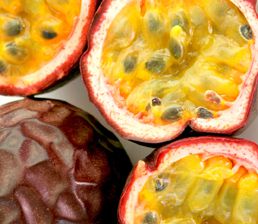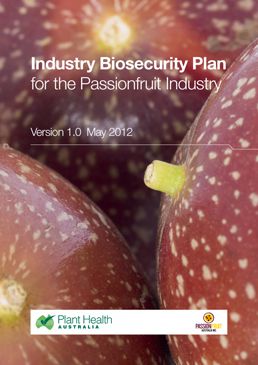 Passionfruit Australia represents the biosecurity interests of passionfruit producers and the industry. They are members of Plant Health Australia and signatories to the Emergency Plant Pest Response Deed. Their responsibilities include:
Passionfruit Australia represents the biosecurity interests of passionfruit producers and the industry. They are members of Plant Health Australia and signatories to the Emergency Plant Pest Response Deed. Their responsibilities include:
- biosecurity planning and implementation at the national and farm levels
- liaising with federal and state governments on trade issues
- funding and supporting biosecurity initiatives
- participating in national committees and response efforts in an emergency.
Industry overview
At present, there is a minimal amount of passionfruit exported.
There is currently around 280 hectares of passionfruit under cultivation in Australia with around 375,000 passionfruit vines. About 60 per cent of the Australian passionfruit crop is grown in Queensland, and around one third in New South Wales. The industry is starting to expand in Western Australia, and there are new plantings in the Northern Territory and Victoria.
Passionfruit is grown year-round, but main market supply time is December through to September. The main purple passionfruit varieties grown are Misty Gem and Sweetheart, and the major Panama passionfruit varieties are Pandora and Panama Red. A National Breeding Program is continuing with the goal of developing new commercial varieties in the next five years. New varieties bred in the Northern Territory designed for tropical regions are also in the process of being commercialised.
Biosecurity plans, manuals and resources
Expand
 Industry Biosecurity Plan for the Passionfruit Industry
Industry Biosecurity Plan for the Passionfruit Industry
Biosecurity planning provides a mechanism for the passionfruit industry, government and other relevant stakeholders to assess current biosecurity practices and future biosecurity needs. Planning identifies procedures that can be put in place to reduce the chance of pests reaching our borders or minimise the impact if a pest incursion occurs.
The Industry Biosecurity Plan for the Passionfruit Industry outlines key threats to the industry, risk mitigation plans, identification and categorisation of exotic pests and contingency plans. For a copy, please contact PHA on 02 6215 7700 or email biosecurity@phau.com.au
 The Exotic Pest Identification and Surveillance Guide for Tropical Horticulture was developed with funding from the Australia Government Department of Agriculture and Water Resources.
The Exotic Pest Identification and Surveillance Guide for Tropical Horticulture was developed with funding from the Australia Government Department of Agriculture and Water Resources.
Inspecting crops for signs of new pests is one way growers can protect Australia’s plant industries from exotic pests, as early detection and reporting improves the chances of successfully containing or eradicating new pests. The guide is in two sections:
• Biosecurity and surveillance
• Identification of key exotic pests.
 Postcard
Postcard
Promotional item to support the exotic plant pest hotline 1800 084 881
Pollination information
Expand
Fact sheets and web links about the pollination of passionfruit are listed below. Please be aware that some of the information was developed overseas, and environmental and seasonal variations may occur.
Passionfruit pollination fact sheet, The Pollination Program (Agrifutures Australia and Hort Innovation)
Passionfruit, Purdue University, Indiana
Pests
Expand
Exotic pests (not in Australia)
The following is a list of high priority exotic pests of passionfruit. These pests were identified during the development of the Industry Biosecurity Plan for the Passionfruit Industry in consultation with industry, government and scientists. They have been assessed as high priority pests based on their potential to enter, establish, and spread in Australia (eg environmental factors, host range, vectors) and the cost to industry of control measures.
PHA has a range of fact sheets, contingency plans and diagnostic protocols relevant to these pests. Pest risk review documents are also available for some pests. Please contact PHA on 02 6215 7700 or email biosecurity@phau.com.au for more information.
Endorsed National Diagnostic Protocols are available from the National Plant Biosecurity Diagnostic Network webpage.
Other pests
The following is a list of documents for other exotic and endemic pests of the passionfruit industry. Please note that this is not a complete list of pests: rather it includes pests for which documents exist in the Pest Information Document Database.
Some of the documents presented here are not tailored to the passionfruit industry and are included for information only.
 Passionfruit Australia represents the biosecurity interests of passionfruit producers and the industry. They are members of Plant Health Australia and signatories to the Emergency Plant Pest Response Deed. Their responsibilities include:
Passionfruit Australia represents the biosecurity interests of passionfruit producers and the industry. They are members of Plant Health Australia and signatories to the Emergency Plant Pest Response Deed. Their responsibilities include:







Recent Comments